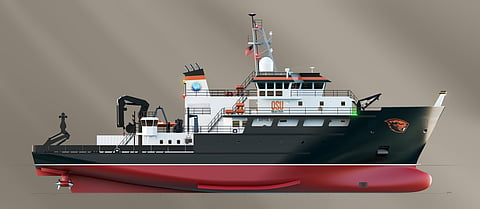

Oregon State University (OSU) has received a grant of US$121.88 million from the US National Science Foundation to spearhead the construction of a new class of research vessels for the United States academic research fleet. It is the largest grant in the university's history.
This grant will fund the construction of the first of three planned vessels approved by US Congress for research in coastal regions of the continental United States and Alaska. According to OSU, when funding for the next two vessels is authorised, the total grant to OSU could increase to as much as $365 million. The first vessel is slated to be operated by OSU for research missions focusing on the U.S. West Coast. The NSF will begin the competitive selection of operating institutions for the second and third vessels later this year – likely to universities or consortia for operations on the US East Coast and the Gulf of Mexico.
OSU was selected by the National Science Foundation in 2013 to lead the initial design phase for the new vessels, and to develop and execute a competitive selection for a shipyard in the United States to build it. Gulf Island Shipyards was chosen and will conduct the detailed design verification over the next year. Officials hope to have a keel-laying ceremony for the first vessel in the spring of 2018, with the ship delivered to OSU for a year of extensive testing in 2020.
This new class of modern well-equipped ships is essential to support research encompassing marine physical, chemical, biological and geologic processes in coastal waters, said Roberta Marinelli, dean of Oregon State's College of Earth, Ocean, and Atmospheric Sciences.
"Rising sea levels, ocean acidification, low-oxygen waters or 'hypoxia', declining fisheries, offshore energy, and the threat of catastrophic tsunamis are issues not only in the Pacific Northwest but around the world," Marinelli said. "These new vessels will provide valuable scientific capacity for better understanding our changing oceans."
The ships will be equipped to conduct detailed seafloor mapping, to reveal geologic structures important to understanding processes such as subduction zone earthquakes that may trigger tsunamis. The Pacific Northwest is considered a high-risk region because of the Cascadia Subduction Zone, which has produced about two dozen major earthquakes of magnitude 8.0 or greater over the past 10,000 years.
The new ships will also be equipped with advanced sensors that will be used to detect and characterise harmful algal blooms, changing ocean chemistry, and the interactions between the sea and atmosphere. OSU hopes the emerging fields of wave, tidal and wind energy will benefit from ship observations. Oregon State is the site of the Northwest National Marine Renewable Energy Center, which in December was awarded a grant of up to $35 million from the US Department of Energy to create the world's premier wave energy test facility in Newport.
The new Regional-class research vessels (RCRVs) will be 58.8 metres long, have a cruising speed of 11.5 knots and maximum speed of 13 knots, and range of approximately 7,000 nautical miles. 16 berths will be available for scientists and 13 for crew members, and the vessels will have the wbility to stay out at sea for at least 21 days before returning to port.
"This class of ships will enable researchers to work much more safely and efficiently at sea because of better handling and stability, more capacity for instrumentation and less noise," said Clare Reimers, a professor in the College of Earth, Ocean, and Atmospheric Sciences and project co-leader. "The design also has numerous 'green' features, including an optimised hull form, waste heat recovery, LED lighting, and variable speed power generation."
Oregon State is expected to begin operating the first of the new ships in the fall of 2021, after a year of testing.
